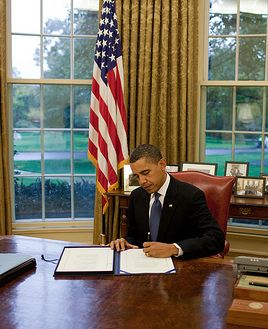 With little fanfare, President Obama signed in early October an executive order that will reduce the carbon footprint of the federal government. Federal agencies are ordered to set a 2020 greenhouse gas emissions reduction target within 90 days; increase energy efficiency; reduce fleet petroleum consumption; conserve water; reduce waste; support sustainable communities; and leverage Federal purchasing power to promote environmentally-responsible products and technologies.
With little fanfare, President Obama signed in early October an executive order that will reduce the carbon footprint of the federal government. Federal agencies are ordered to set a 2020 greenhouse gas emissions reduction target within 90 days; increase energy efficiency; reduce fleet petroleum consumption; conserve water; reduce waste; support sustainable communities; and leverage Federal purchasing power to promote environmentally-responsible products and technologies.
“As the largest consumer of energy in the U.S. economy, the Federal government can and should lead by example when it comes to creating innovative ways to reduce greenhouse gas emissions, increase energy efficiency, conserve water, reduce waste, and use environmentally-responsible products and technologies,” said President Obama. “This Executive Order builds on the momentum of the Recovery Act to help create a clean energy economy and demonstrates the Federal government’s commitment, over and above what is already being done, to reducing emissions and saving money.”
The federal government occupies nearly 500,000 buildings, operates more than 600,000 vehicles, employs more than 1.8 million civilians, and purchases more than $500 billion per year in goods and services.
Finding cost-effective reductions and energy savings will benefit the taxpayer in a number of ways beyond saving money and easing the burden on landfills. Projections include:
* 30% reduction in vehicle petroleum use by 2020;
* 26% improvement in water efficiency by 2020;
* 50% recycling and waste diversion by 2015;
* 95% of all applicable contracts will meet sustainability requirements;
* Implementation of the 2030 net-zero-energy building requirement;
* Stormwater management
* Development of guidance for sustainable Federal building locations in alignment with the Livability Principles put forward by the Department of Housing and Urban Development, the Department of Transportation, and the Environmental Protection Agency.
Examples of Federal employees and their facilities promoting environmental stewardship exist throughout the country. Many federal agencies have received recognition for their work to integrate environmental considerations into their daily operations and management decisions including: the Air Force Sheppard Air Force Base in Texas for their “Sheppard Puts the R in Recycling” program, the Department of Treasury for their petroleum use reduction, the Department of Energy Y-12 National Security Complex in Tennessee for pollution prevention, the United States Postal Service for their Green Purchasing Program and the U.S. Department of Agriculture “Sowing the Seeds for Change” Extreme Makeover Team in Minnesota.
(White House press release)



















